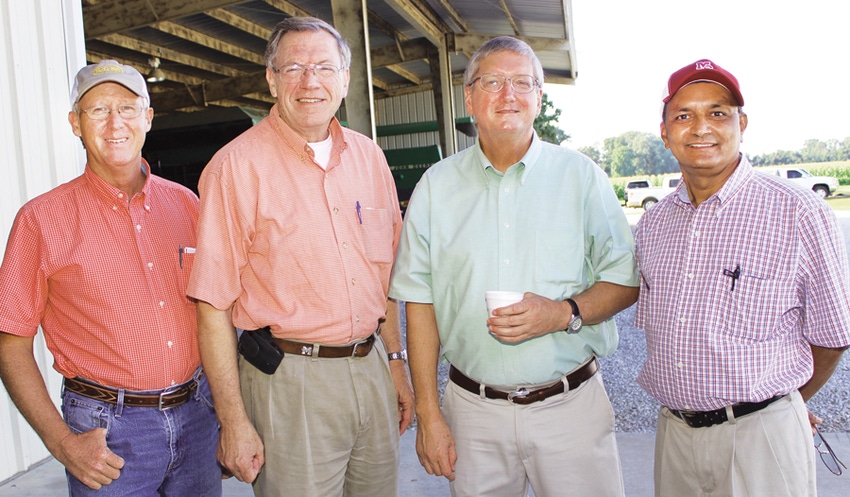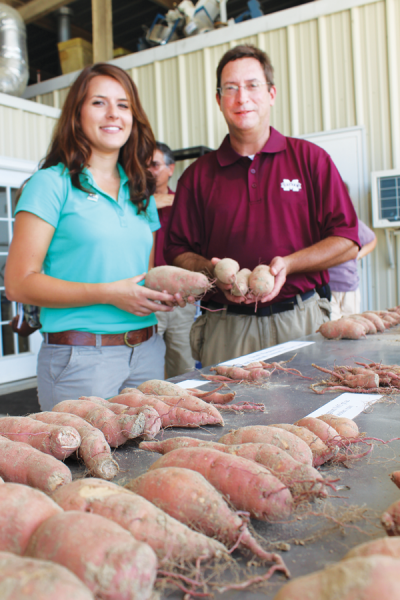
Weather-shortened crop foretells stronger prices for sweet potatoes
Heavy rains that are expected to reduced sweet potato production in the Southeast may mean stronger prices for Mississippi and Louisiana growers, Benny Graves, executive director of the Mississippi Sweet Potato Council, said at the state's sweet potato field day.

With sweet potato harvest expected to swing into high gear following the Labor Day holiday, growers in Mississippi and Louisiana are looking forward to higher prices occasioned by a weather-shortened crop in North Carolina, the nation’s largest producer.
Heavy rains through the growing season have cut into that state’s expected yields, Benny Graves, executive director of the Mississippi Sweet Potato Council, said at the sweet potato field day held at the Pontotoc Ridge/Flatwoods Experiment Station at Algoma, and that could brighten the profit outlook for growers.
“Availability drives the market,” he says, "and prospects for a reduced crop nationally pushed the price “from $15 a bushel to $18.50 a bushel in about three weeks."
Ag news delivered daily to your inbox: Subscribe to Delta Farm Press Daily.
Most of Mississippi’s crop is concentrated around the Calhoun County town of Vardaman, where there a number of packing sheds and shipping facilities, and in adjacent Chickasaw, Pontotoc, Webster, and Grenada Counties, Sweet potatoes have been grown in the area since the early 1900s.
Mississippi ranks second in the nation in sweet potato production, and production last year had an economic value to the state of $78 million, Graves says.

STEVE MEYERS
Acreage in the state is down this year, according to figures compiled by Graves and Steve Meyers, northeast regional Extension specialist at Pontotoc, who serves as the state’s sweet potato specialist.
“Last year we had 22,500 planted acres,” Meyers says. “This year, that’s down 18 percent to 18,450 planted acres.
“As with much of the South, our cropping season started cool and wet, with plant beds going out somewhat later than last year. Overall, though, those plant beds look better than might be expected under those circumstances.
“Our first transplanting went out May 25-26, and throughout most of May and first three weeks of June, we had ideal transplanting conditions — good soil moisture, with temperatures in the mid-80s and lows in the upper 60s — for setting plants and getting a good stand and good root set.”
In the last week of June and into July, Meyers says, hot weather and dry soils caused stand reduction in plantings at that time, and “we’ll probably see some reduced set in those plants.
“By and large, the crop looks pretty good. With harvest near, Benny Graves and I estimate that about 20 percent of the crop is marginal to good, and 80 percent good to excellent.
“We’ve seen a lot of hand pulling of weeds. That’s something we expect in sweet potatoes, given that there is a limited number of herbicides available for use in the crop, and for some of the weeds we have in our fields there just isn’t an efficacious herbicide.
“We’ve seen a lot of nutsedge breaking through this year. Dual is really the only thing we have for control, and timing has to be right on target. We’ve also seen a lot of coffeeweed popping through, a lot of cocklebur, and a lot of hophornbeam copperleaf.”
Research aims to improve sweet potato yield, quality
In the pest sector, Meyers says, “We’ve seen some reniform nematode injury in some fields, causing stunted potatoes.
Reduce nematodes with rotation
"We’re encouraging growers, where they can, to rotate to a non-reniform host crop like corn or sorghum. Peanuts can also be a suitable rotation crop for those who can grow them.
“Insect pressures have been low, for the most part. Cucumber beetles are the predominant insect we’re seeing right now, with some armyworms beginning to come in. We’re also keeping an eye out for the sugarcane beetle.
“With the crop maturing, four-legged pests are also a problem for some growers. Deer have figured out that there are sweet potatoes under the soil, and they’re starting to dig around in fields. Wild hogs have been troublesome for some of our growers.”
Although he said he’d had reports of some harvesting in late August, “I expect things to be in full swing after the Labor Day Holiday.”
Meyers, who filled the Extension sweet potato specialist position in January, notes that there now is a sweet potato page on the Mississippi State University MSU Cares website.
“It contains a lot of the presentations we give throughout the year, links to pest management recommendations , and links to other sites of interest.
“Sweet potatoes are also on the Mississippi Crops Situation blog, where a lot of the Extension agronomic and research specialists post updates about what they’re seeing in the field and questions growers are posing.”
The U.S. Sweet Potato Council will meet in New Orleans this year, Meyers says. Information about the meeting and registration/reservations details can be found here.

MAVIS FINGER, Louisiana State University AgCenter sweet potato specialist, and Mark Shankle, research professor at the Pontotoc Ridge/Flatwoods Experiment Station, examine sweet potatoes that have had varying herbicide treatments.
Mavis Finger, Louisiana State University AgCenter sweet potato specialist at Winnsboro, La., said growers in her state also were delayed in planting due to cooler than normal springtime temperatures and consistent rains from late May to June, which brought an increase in disease and breakdown of seed roots.
“We had 7,500 acres planted this year, a 25 percent reduction from 2012,” she says. “We had adequate rainfall during planting and the early growing season, but additional moisture is needed to finish sizing.
Why fewer sweet potato acres in Louisiana?
“Growers with irrigation have been using that to keep the crop on schedule. As of Aug. 15, some of our producers in the southern part of the Louisiana were beginning harvest, but statewide harvest is expected to begin about Sept. 10.”
LSU AgCenter is focusing on increasing production efficiency of sweet potatoes, Finger says, to optimize production practices for both the fresh market and processing sectors.
“Tara Smith, who previously held this position, is now involved more with administrative duties, but is still focused on research and still is coordinator of the Sweet Potato Research Station at Chase, La. She heads the virus tested seed program and also evaluates insecticides for sugarcane beetle control.”
Two new varieties released from the Louisiana program last year “are starting to become quite popular,” Finger says. “Orleans, which is similar in many respects to Beauregard, the industry standard, has similar skin, flesh color and taste. It has been well-accepted in the fresh market. Orleans wins over Beauregard in terms of shape — if you have bins side by side, you can see that Orleans is slightly better in shape. Overall, also, hill-to-hill consistency is better.”
The other variety, LA 07-146, is “unique,” she says, in that it’s licensed to ConAgra. “Louisiana growers can grow and sell this variety in the fresh market, but out-of-state growers would need a license to grow it.” It has a “very attractive red skin,” Finger says, and sugar content is similar to Evangeline, “so it’s very sweet. Its biggest strength is yield — it has a 15 percent to 20 percent higher yield than Beauregard.”
The Louisiana station has more than 75 years of sweet potato breeding experience, the oldest program of its kind in the world.
You might also like: Mississippi sweet potato research goals: higher yields, quality
About the Author(s)
You May Also Like



